27. Iconography of the Sea World on Late Hellenistic Bronze Vessels
- Klara De Decker, Westfälische-Wilhelms-Universität, Münster
Abstract
The Mediterranean Sea has always captured the imagination of the Greeks, but at the end of the Hellenistic era, their artistic vision and technical knowledge were transferred to the Italian peninsula, where Roman craftsmen created artifacts that surpassed everything before. These craftsmen portrayed deities such as Poseidon, Amphitrite, Triton, Scylla, and Medusa, who lived in the sea, riding creatures like sea horses (hippocampi), sea wolves (ketos), dolphins, and other real and imaginary marine animals.1 Wealthy Romans ate exotic meals off expensive tableware, in solemn settings;2 some of their dishes were metal vessels decorated with reliefs (fig. 27.1).3 The excavations at Pompeii and Herculaneum have led to the discovery of close to seventeen hundred bronze vessels, which can be categorized in any number of ways. Our interest here is in the iconography on the vertical part of the vessels’ handles. The subjects can be divided into three main groups:
Reliefs depicting only vegetal motifs, such as tendrils, sprouts, and leaves.4
Reliefs depicting Dionysian objects (tympanon, crotalon, mask, thyrsos, or narthex), plants (ivy, grapes, poppies, and pomegranates), or animals (panthers, lions, and goats).5
Reliefs depicting sea life, such as hippocampi, fish, and sea deities.6
The sea themes are used particularly to decorate the handles; the lower attachment often ends with a face or figure of Medusa, Scylla, a Tritoness, or Triton, the faces of the latter two usually covered with kelp and seaweed. We will describe several such vessels, followed by a discussion of their significance.
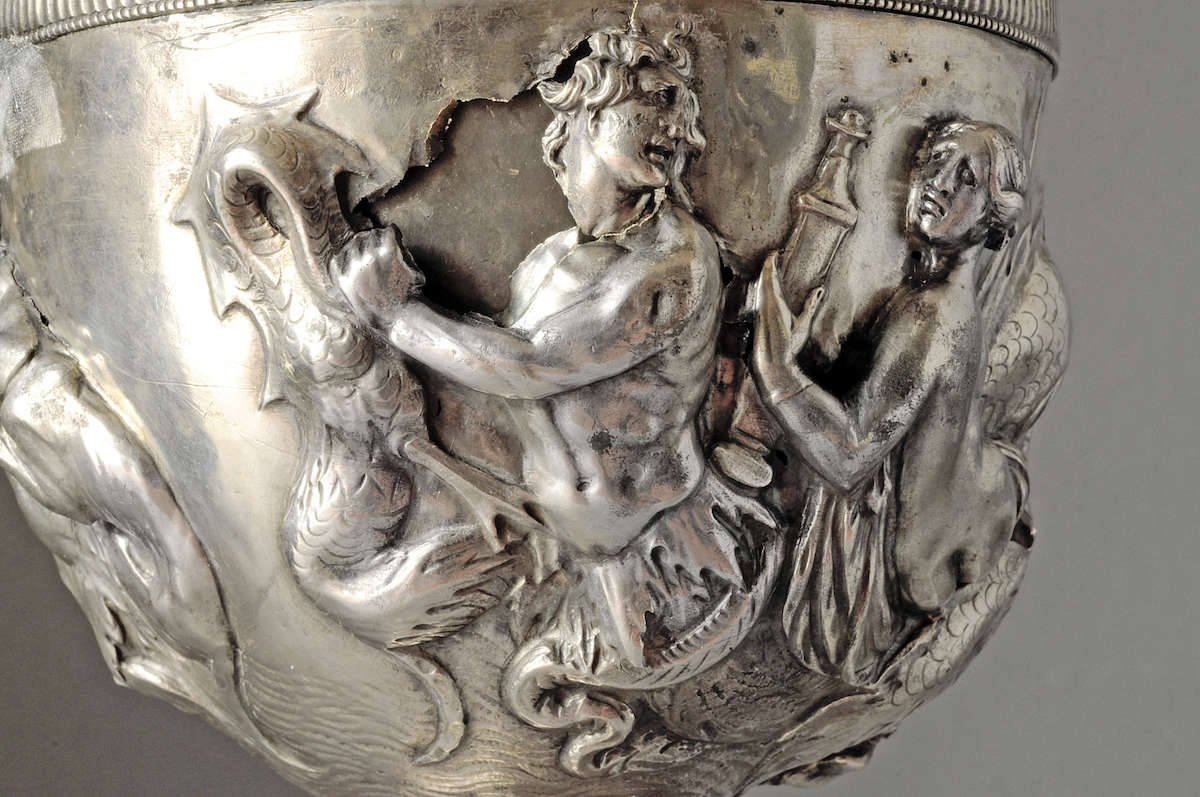
A Pathetic Triton7
The first vessel under discussion is a bronze calyx-krater with pedestal in the Museo Archeologico Nazionale, Naples, which was found on May 16, 1873, at Pompeii, in the atrium of the house designated II 2.10 (fig. 27.2).8 It is high-quality imported ware, dating to the second quarter of the first century BC. Its height is 75.5 centimeters (29 ¾ in.) including the handles. The krater has two curled handles, decorated at the top with three acanthus leaves. Below, the handles have oval attachments on each side, with acanthus leaves in low relief covering them. There is an emblema in between, which is soldered onto the shoulder of the krater. On it, a somber image of Triton can be seen in high relief; one side has black patina, the other side verdigris. A male face with silver-inlaid eyes (now missing) is framed by tousled hair in which are entangled the fishtails of two sea wolves. The ears are shaped like mussels; seaweed trails over the eyebrows; fins stick out behind the jaw. The open lips show copper inlay, displaying teeth inlaid with silver. Under his chin, two sea panthers hold an octopus. Made at the end of the Late Hellenistic period in open-work technique, the handle has several parts soldered on, namely the head of the sea wolf, lips, and fins. On the black-patinated side, one of the two sea wolves is broken.9
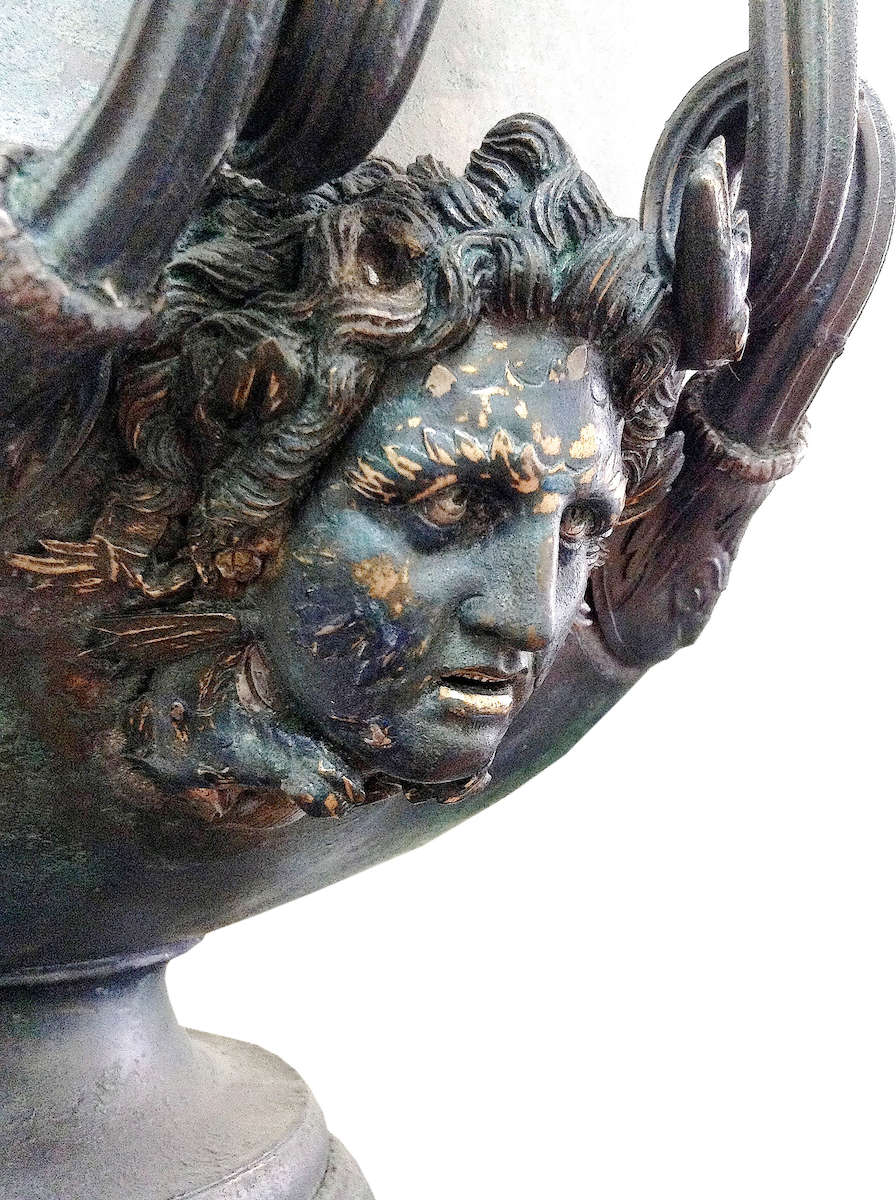
A Two-Faced Triton
The calyx-krater with pedestal, now in Berlin, is from Boscoreale.10 Its height is 64 centimeters (25 ¼ in.) including the handles. The handle was analyzed in 2001 at the Rathgen Labor using atomic absorption spectrometry; it was found to be 84.7 percent copper, 11.47 percent tin, and less than 1 percent lead. The alloy was typical for South Italian bronze casting, according to Josef Riederer.11 These results confirm Andreas Oettel’s earlier supposition that the krater was manufactured in Campania, although Eastern artisans cannot be ruled out.12 Various dates have been proposed for this vessel; Lucia Pirzio Biroli Stefanelli suggested the second half of the first century BC;13 Anna Elisabeth Riz suggested the second quarter of the first century BC;14 Erich Pernice favored a date after the Augustan period.15
The handles of the Boscoreale krater are decorated in low relief, displaying acanthus leaves. It has simple, half-oval attachments. Its uniqueness lies in the fact that Triton is depicted as both male and female on the same vessel in high relief. The male face, unlike the female, is covered with seaweed, like the retreating waves; the female face, by contrast, is smooth and peaceful, like a calm sea. In the wavy hair (which they share), there are several snakes, and the ears are mussel-shaped. Under the chin is an octopus; along the face are two sea wolves with gaping mouths. The high relief is made with the utmost care and skill, its light-and-dark contrasts showing up particularly well among the locks of hair. The whole composition consists of a single block. This artifact shows great technical skill but does not use open-worked surfaces. Because of this, we suggest a date the end of the first century BC to the beginning of the first century AD.
A Grim-Faced Deity
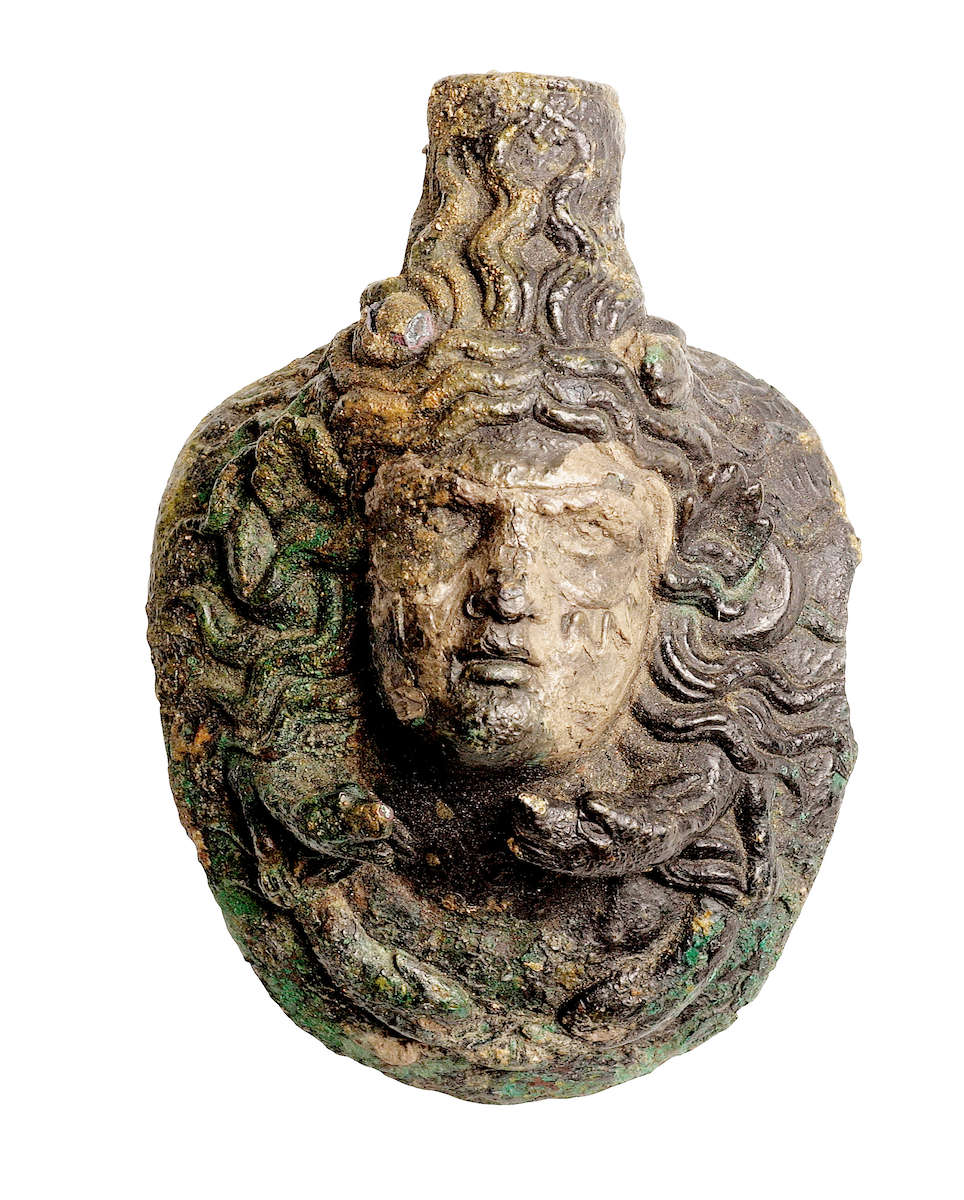
Handle fragments (lower attachment) from a calyx-krater, now in Geneva, were retrieved from Ostia (fig. 27.3).16 The length of the handle is 9.2 centimeters (3 ⅝ in.). It shows a male face in whose tousled hair two serpent heads writhe. The ears are again shaped like mussels, and seaweed clings above the eyebrows; the eyes, once glass or silver, are now lost. The face is covered with kelp; the mouth is slightly open. Two dogs are under his chin, and below that, two dolphins with an octopus between them. As to the iconography, several hypotheses have been advanced. Walther Fol thought it could represent Medusa;17 Waldemar Deonna suggested Scylla;18 and finally Christiane Dunant proposed that it might be a Triton or another sea god.19 The seaweed would be typical for Triton. One is immediately struck by the rather grim expression of the deity. Paired animal figures, like the dog heads and dolphins surrounding an octopus and placed symmetrically, are common motifs (see “The Two-Faced Triton” from Boscoreale). The workshop was likely in Campania or Capua, or in the East.20 Our estimated date for this handle fragment is post-Augustan to middle of the first century AD. The three works listed so far are in chronological order, the earliest being the Pompeian krater, followed by the Boscoreale krater, and finally this piece.
There are numerous comparanda for the shape:21 a silver kantharos from the northeast Mediterranean, but without handle, dated between 46 and 15 BC;22 a large krater from the Hildesheim treasure (a collection of silver wares of various origins), surely earlier than the middle of the first century AD;23 and a kantharos from the West Cemetery at Meroë with Greek inscription.24 Handles formed from two curled rods were common since the Early Hellenistic period.25
Tritons, Young and Old
A silver handle at the J. Paul Getty Museum, which likely once belonged to an askos, shows an older but still very powerful Triton. The length of the handle is 24 centimeters (9 ½ in.). His mustache and beard frame his thick-lipped mouth; he has intense large eyes and equine ears.26 The pathos in his facial expression is typical of the Hellenistic style. The handle was dated by Beryl Barr-Sharrar between 100 and 50 BC, the region of production being probably around Tarentum in Magna Graecia.27
Our next example, in the Petit Palais, Paris, may have been found near Smyrna. It is of a type similar to the Getty handle, but it has a female torso ending in a long scabrous tail. It wears a double crown of acanthus leaves. Judith Petit considers it a Roman work and connects it to art from Asia Minor.28
Another interesting bronze is the Triton and hippocampus statuette group in the Elie Borowski collection.29 Triton is depicted as a muscular youth, with semi-long tousled hair and wearing a loincloth made of three rows of acanthus leaves. The hippocampus is constrained with the crab claws of Triton, his demeanor exuding truculence. The group was made around 180 BC and is considered the work of a Rhodian artist.30
The next significant example of a bronze vessel handle is again in the J. Paul Getty Museum,31 formerly part of the Fleischman Collection. It shows a young woman, perhaps a Tritoness or Scylla (depicted without dogs), which lies above an enlarged face of an old Triton. She holds a rudder in her right hand and appears peaceful; her long hair is parted in the middle, and she is wearing a simple crown or a hair band. She is naked save for a skirt made of long acanthus leaves that ends in a curved, hook-like fishtail. Crab claws typical of pereiopods reach out from underneath Triton’s thick hair; his face is covered in seaweed, his mouth is agape, with two dolphins beneath the chin; the eyes and fins along the jaw are made in silver inlay. This is a manifestation of a solemn or philosophical Triton and can be dated from the late first century BC to the early first century AD.32
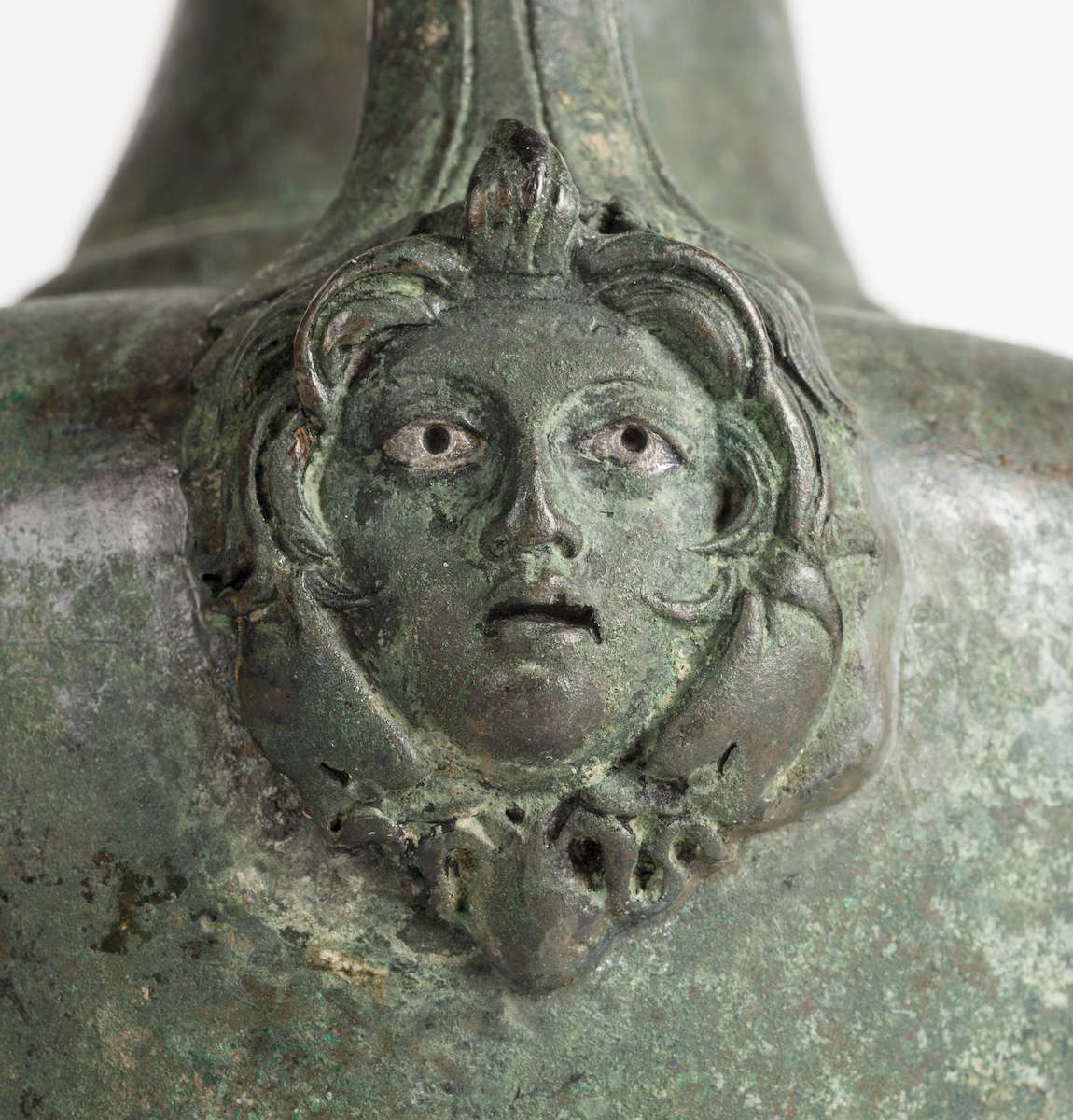
Another handle belonging to Tassinari’s Pompeian Type B 1222,33 in the Archaeological Museum in Naples, is from Herculaneum (fig. 27.4).34 The length of the handle is decorated in low relief, with a face peering through acanthus leaves, then an unfurling scroll of acanthus leaves from the side, with a bordering bead pattern. The lower attachment, in high relief, bears a mask of a sea god; there are two wings in his tousled hair, with snakes, dogs, and coiled serpents in three sets above. He has mussel ears, silver-encrusted eyes, a seaweed-covered face, an open mouth, inlaid silver teeth, and a chin ending in a knotted serpent’s tail. Below this on the left and right are dolphins holding an octopus in the center with their open mouths.35 The composition in high relief is an open work and the surface is not continuous; these details are characteristic for the period from the second half of the first century BC to the middle of the first century AD.36
Then we have two jugs with large mouths, again Type B 1222 and also in Naples, which were found in Pompeii in 1862.37 Their height is 41.5 centimeters (16 ¼ in.). The jugs are of high quality; the body color is verdigris, and the rim has two grooves. The horizontal part of the handle is flanked, left and right, by birds’ heads; in the center of the two attachments is a thumb rest in the form of a curved leaf, originally inlaid with silver. The transverse band consists of three rows of beads, dividing the horizontal and vertical parts. The vertical part of the handle is in low relief with a scroll of twisting leaves on the sides, edged again by a beaded pattern. The lower attachment depicts the face of a sea god; in his tousled hair are two ketoi, his face is covered with seaweed, and under his chin are two dolphins and an octopus in high relief, with silver inlay in the eyes.38 The composition of the Triton is entirely closed. This piece comes from the middle of the first century AD.
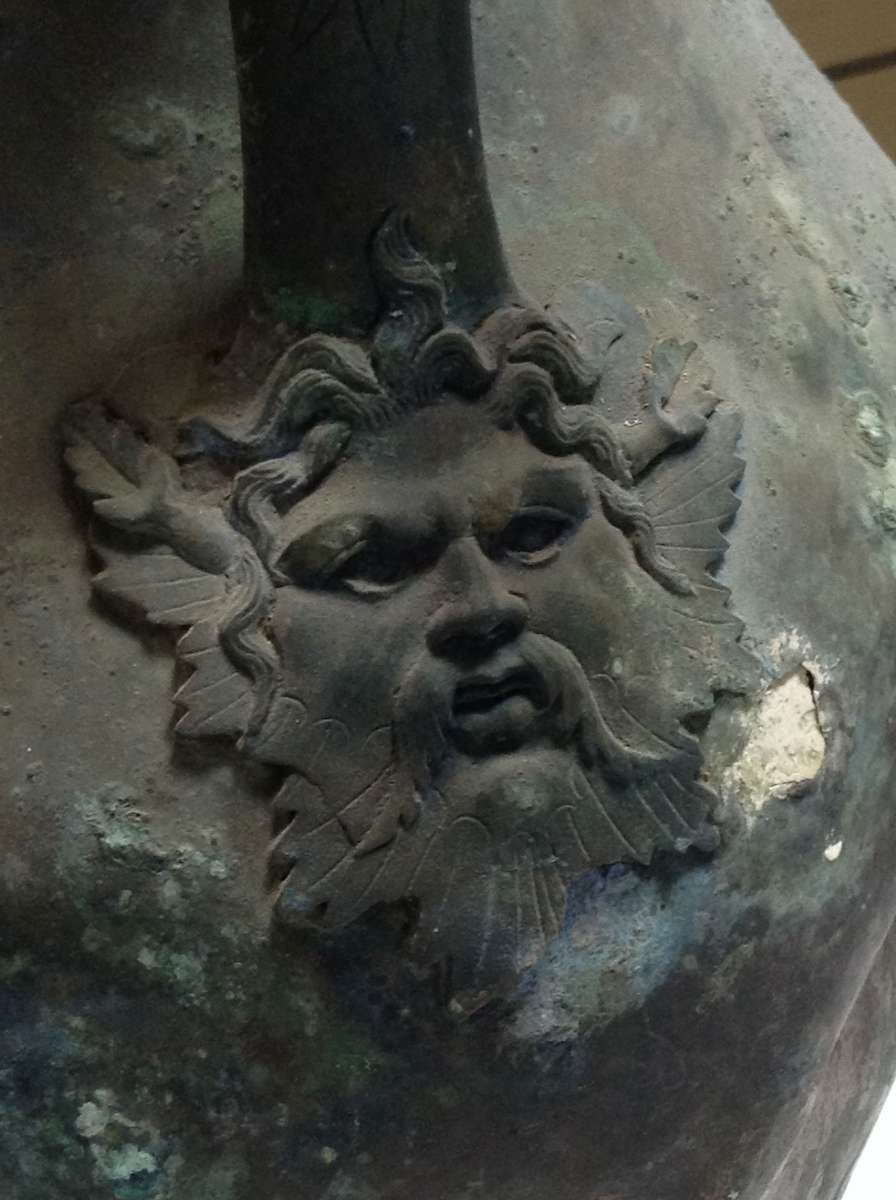
One of the bigger jugs of Type B 1222 was found in the cubiculum of the Casa dell’Ara Massima in Pompeii; its height is 42.6 centimeters (16 ¾ in.), including the handles (fig. 27.5).39 The jug’s rim has numerous grooves; the body is large, and its bottom consists of several concentric circles in high relief. The top of the handle depicts horizontal bird heads, rather plainly; the thumb rest in the center has thin leaves around it. The transverse band consists of three lines of beaded decoration; as is often the case, the silver inlay is missing. The vertical part of the handle has a cascade of leaves in low relief. The lower attachment is decorated with a vine leaf in the background, and Triton with his free-flowing hair has been placed over it. He has shell ears, but here the ears look more pointy than shell-like. His face is covered with seaweed. The iconographic significance is that the head of Triton now incorporates many Dionysian elements. The craftsmanship is of lower quality in comparison to the previously mentioned works and, again, the silver inlays in the eyes are missing. The composition is entirely closed. The piece looks very much like something mass-produced or made by an apprentice just learning his craft. The date of manufacture is the middle of the first century AD or somewhat later; the piece was probably produced in Alexandria, as indicated by the engraved leaves and the thumb rest with a crown of leaves.
Still another jug, also belonging to Type B 1222, comes from Pompeii I 9.5, the House of the Orchard (Casa del frutteto).40 Its height is 37.2 centimeters (14 ½ in.) including the handles; the length of the handle alone is 21.5 centimeters (8 ½ in.). In line with the previous examples, its transverse band consists of three lines of beads, the silver inlay long ago eroded. The vertical part has a line of leaves in low relief; the surface has lost definition and become quite worn over time. The lower attachment is decorated with a male head in high relief, his wild wavy hair with a taenia on top with two wings; the forehead is covered with seaweed.41 The iconographic emphasis here shows once more how Triton appears with Dionysiac elements (e.g., the taenia), but his expression is severe. The composition is closed. Manufacturing date seems to be the middle of the first century AD or after, probably from a workshop at Alexandria but fashioned after a different model from the previous handle.
Conclusion
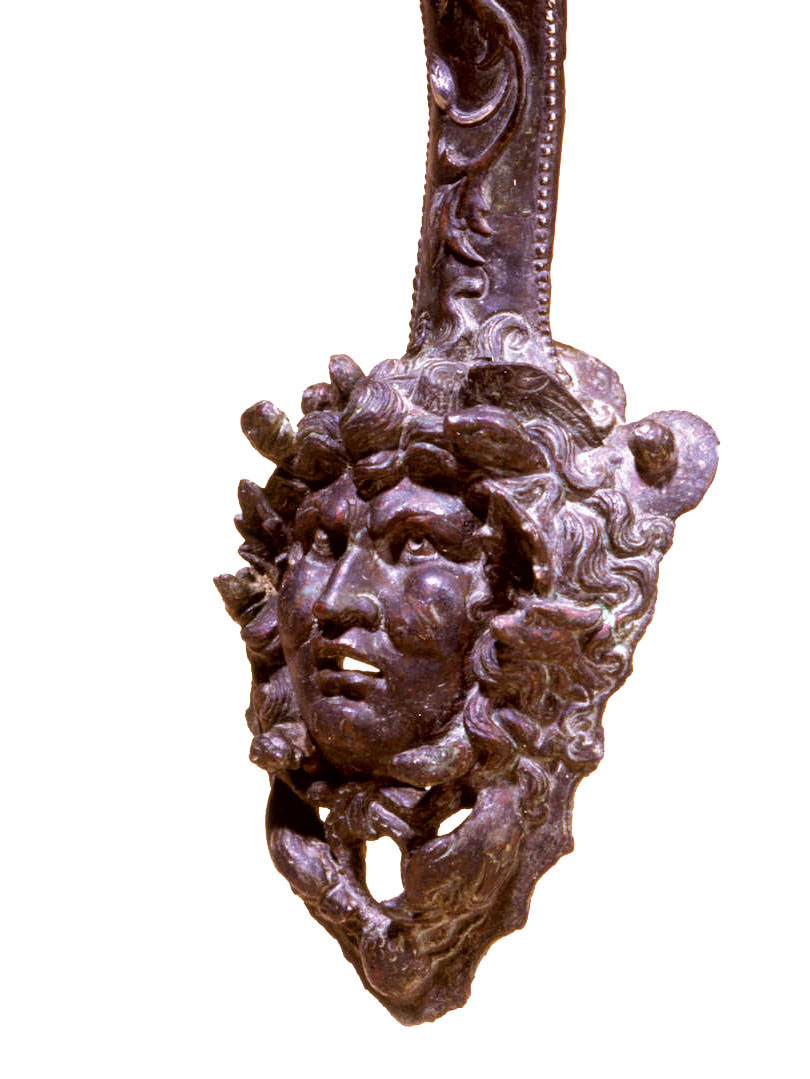
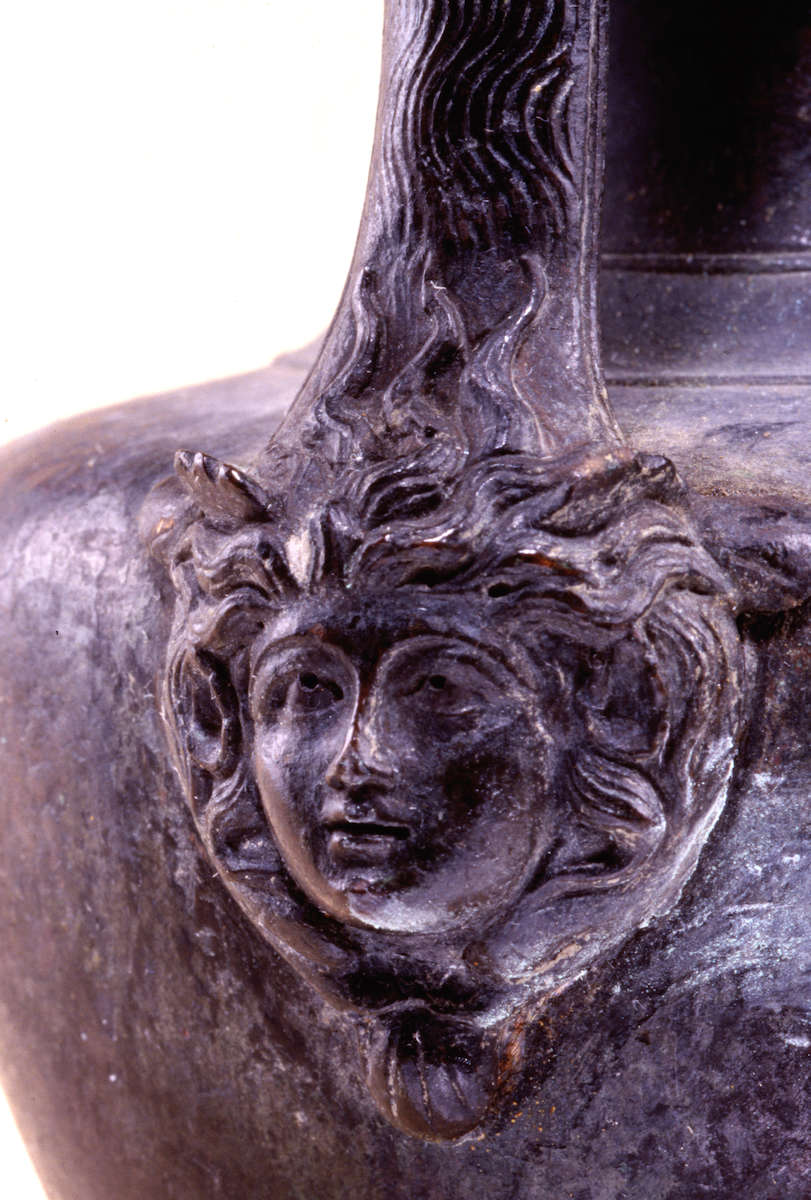
It seems hardly coincidental that the sea world that artistically inspired the various maritime themes discussed here reflects the cultural, financial, and political issues affecting the human realm. It tells a story of artisans from the East looking for patrons who could afford what we call Hellenistic craftsmanship (fig. 27.6). Traveling across the Mediterranean to cities like Naples or Capua, artists set up their workshops close to their clients. It is highly probable that these artisans became specialized, becoming what we will now call Triton Masters (fig. 27.7). Most of the more ostentatious pieces were made in the mid-first century BC, like the kraters, in which the deities were shown in their traditional iconographical contexts. Even if we don’t know him by name, the master behind these works is recognizable; take, for instance, the highly detailed mussel-shaped ear of Triton (see figs. 27.2–5, 27.7). Then came a period from the late first century BC, when artifacts are complex open works in high relief, accentuated with silver inlays. This is where the archetypes become more ambiguous. Augustus’s naval victory at Actium in 31 BC became associated with the figure of Triton, and artisans added qualities of Triton to representations of other deities in support of Augustus’s political propaganda (fig. 27.8). This is also the phase when the pathos of Triton is most eloquently expressed. As prosperity increased in the Early Imperial period, lifestyles of the upper class became more lavish and elaborate. Higher demand during this phase—around the middle of the first century AD—caused an increased production and combined with the public’s interest in Alexandrian style to stimulate the next notable development in craftsmanship. The masters in charge began making tableware series using standardized techniques.42 It is also likely that they assigned much of the manufacturing to their apprentices, including many migrants from the East. This would explain why there is such a notable range of quality during this period. The distinctive mussel-ear shape inherited from previous masters devolves into pointed ears; even Triton’s pathos gets lost in the poor execution.
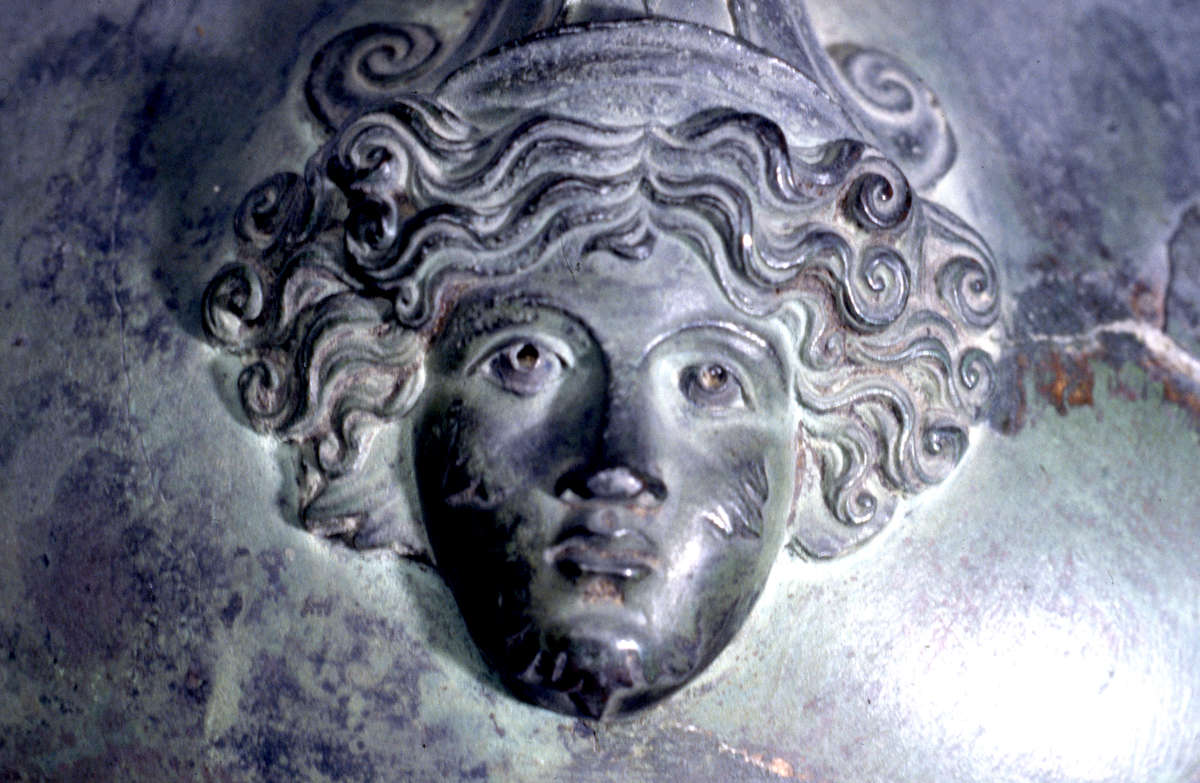
Finally, vessels produced during the last quarter of the first century AD feature a union between Triton and Dionysos. In doing so, the Triton Masters take this deity to his next transformation.
Acknowledgments
Many thanks are due to S. Tassinari, S. Descamps, C. Pouzadoux, V. Sampaolo, A. Villone, F. Miele, A. Milanesi, G. Albano, D. Salzmann, R. Dylka, and J. Chamay.
Notes
- Andreae 2003, 150–53, 270–72. ↩
- Dunbabin 2003, 55, fig. 26. ↩
- De Decker 2007/2008, 93, plate 22.16; Guzzo 2006, 81, no. 8 (Cassetta); 137, no. 168 (Stefani); 140, no. 171 (De Carolis); Stefani 2005, 64, no. 69; Carandini 1977, 166, plate 80.22. ↩
- Tassinari 1975, 175, fig. 7c (Museo Archeologico Nazionale di Napoli [hereafter MANN], inv. 69491). ↩
- Tassinari 1975, 167, fig. 3a (MANN, inv. 69488). ↩
- For example, Balty 1965, 52 no. 25; p. 54, no. 52, plates 6–7; Tassinari 1975, 169, fig. 4d (MANN, inv. 69489); Faider-Feytmans 1979, 177, no. 362; Tassinari 2002, 367, fig. 8; Ratković 2005, 74, no. 21; MANN, inv. 115565 and 115570. ↩
- LIMC 8 (1997), 68–85, s.v. “Triton, Tritones” (Icard-Gianolio). ↩
- MANN, inv. 109697. History of the find: MANN Archivio storico, folio 47, no. 1. (I am very grateful for the support I received when using the archive.) ↩
- Riz 1990, 38, plate 5.2. ↩
- Berlin, Staatliche Museen, Antikensammlung, inv. Misc. 8850. Boscoreale, K. 23, finding group 1: Oettel 1990, 24. ↩
- Riederer 2001, 177–98. The full results were: Cu 84.7%, Sn 11.47%, Pb 0.8%, Zn 0.002%, Fe 0.13%, Ni 0.11%, Ag 0.08%, Sb 0.02%, As 0.05%, Bi 0.025%, Co 0.005%, Au 0.01%, Cd 0.001%. ↩
- Oettel 1990, 25–26. ↩
- Pirzio Biroli Stefanelli 1990, 253, 284, fig. 240, no. 121. ↩
- Riz 1990, 38, plate 5.2. ↩
- Pernice 1925, 40–41, figs. 50–51, group III. ↩
- Geneva, Musée d’Art et d’histoire, inv. MF 1207: Fol 1874, 261, no. 1207. ↩
- Fol 1874, 261. ↩
- Deonna 1912, 39. ↩
- Dunant 1967, 110–14. ↩
- Riz 1990, 42–48. ↩
- The typology belongs to Y 1100: see Tassinari 1993, 2: 344–45. ↩
- Oliver 1980, 159–61, 166, figs. 10–11. ↩
- Pernice and Winter 1901, 64–65, plate 35. ↩
- Mielsch and Niemeyer 2001, 3–4, fig. 1. ↩
- Trofimova 2007, 170–73, nos. 74 and 76, from the Crimea (third century BC). Other comparanda include: Oliver 1977, 48–50, nos. 17–18; Oliver 1977, 64–65, nos. 31–32 (early Hellenistic); Oliver 1977, 100–101, nos. 56–57 (Tivoli hoard, dated mid-first century BC); Oliver 1977, 124–25, nos. 78–79, from a burial at Olbia, dated first century BC; and finally one from Palmi in South Italy, Guzzo 1980, 203, fig. 6, dated first century BC. ↩
- Los Angeles, J. Paul Getty Museum, inv. 85.AM.163. Barr-Sharrar 1993; cf. Christie’s (New York), Antiquities, June 16, 2006, lot 158; dated second–first century BC. For an identical pair of Tritons as a vessel handle, see Royal Athena Galleries, Art of the Ancient World 73 (1997), 10–11, no. 40, from an Alexandrian workshop. ↩
- Barr-Sharrar 1993, 99–106. ↩
- Petit 1980, 79–80, no. 25. ↩
- Andreae et al. 2002. ↩
- Andreae et al. 2002, 5. ↩
- Los Angeles, J. Paul Getty Museum, inv. 96.AC.181. ↩
- Getty Museum 1994, 272–73, no. 138 (Ariel Herrmann). ↩
- Tassinari 1993, 2:23–39. ↩
- MANN, inv. 72600. ↩
- Tassinari 1975, 175, fig. 7g (face); 189, fig. 14c (the upper attachment of the handle). ↩
- Drexel 1909, 178. ↩
- MANN, inv. 69492–93, found in Pompeii on September 26, 1862. ↩
- Tassinari 1975, 175, 224, fig. 7f, fig. 18e (lower attachment); MANN, inv. 69492. ↩
- Soprintendenza Archeologica di Pompei, inv. 3169, Pompeii VI 16.15 (Casa dell’Ara Massima); Tassinari 1975, 175, figs. 7e and 18b; Tassinari 1993, 1: 179, plate 135.3–4. ↩
- Soprintendenza Archeologica di Pompei, inv. 8579; Tassinari 1993, 1: 139, plate 135.1–2. ↩
- Tassinari 1975, 175 figs. 7d and 18c. ↩
- Nuber 1972. ↩
Bibliography
- Andreae 2003
- Andreae, B. 2003. Antike Bildmosaiken. Mainz: Philipp von Zabern.
- Andreae et al. 2002
- Andreae, B., S. Kansteiner, and M. Kunze. 2002. Meeresgott und Seepferd: Ein neuentdecktes Meisterwerk griechischer Bronzekunst aus Jerusalem. Exh. cat. Stendal, Winckelmann-Museum.
- Balty 1965
- Balty, J.-Ch. 1965. “Une anse d’aiguière d’époque romaine à incrustation d’argent.” BMusBrux 37: 13–77.
- Barr-Sharrar 1993
- Barr-Sharrar, B. 1993. “A Silver Triton in the Getty Museum.” In Studia Varia from the J. Paul Getty Museum 1: 99–106. Malibu: J. Paul Getty Museum.
- Carandini 1977
- Carandini, A. 1977. “Alcune forme bronzee conservate a Pompei e nel Museo Nazionale di Napoli.” In L’Instrumentum domesticum di Ercolano e Pompei nella prima età imperiale, ed. M. Annecchino et al. (Quaderni di cultura materiale 1), 163–68. Rome: L’Erma di Bretschneider.
- Dahy 2005/2006
- Dahy, I. 2005/2006. “La collection de bronzes du Musée de l’Arles et de la Provence antiques: Étude du mobilier issu de découvertes récentes.” Thesis, Université de Provence, Aix–Marseilles III.
- De Decker 2007/2008
- De Decker, K. 2007/2008. “Une olpé au Musée Hongrois des Beaux-Arts: La cruche de Budapest.” Boreas 30/31: 73–103.
- Deonna 1912
- Deonna, W. 1912. “Bronzes du Musée de Genève.” RA 1912.2: 32–42.
- Di Cresce 1995
- Di Cresce, A. 1995. “133 Brocche con imboccatura circolare: B 1240–1260.” Thesis, Università Federico II, Naples.
- Drexel 1909
- Drexel, F. 1909. “Alexandrinische Silbergefässe der Kaiserzeit.” BJb 118: 176–235.
- Dunant 1967
- Dunant, C. 1967. “Une applique de bronze en relief.” In Gestalt und Geschichte: Festschrift Karl Schefold zu seinem 60. Geburtstag am 26. Januar 1965 (Beihefte zur AK 4), ed. M. Rohde-Liegle, 110–14. Bern: Francke.
- Dunbabin 2003
- Dunbabin, K. M. D. 2003. The Roman Banquet: Images of Conviviality. Cambridge: Cambridge University Press.
- Faider-Feytmans 1979
- Faider-Feytmans, G. M. 1979. Les bronzes romains de Belgique. Mainz: Philipp von Zabern.
- Fol 1874
- Fol, W. 1874. Catalogue du Musée Fol: Antiquités. Vol. 1: Céramique et plastique. Geneva: H. Georg Cherbulier.
- Getty Museum 1994
- J. Paul Getty Museum. 1994. A Passion for Antiquities: Ancient Art from the Collection of Barbara and Lawrence Fleischman. Malibu: J. Paul Getty Museum in association with the Cleveland Museum of Art.
- Guzzo 1980
- Guzzo, P. G. 1980. “Argenteria da Palmi in ripostiglio del I sec a C.” AttiMGrecia 18–20 (1977–79): 193–209. Rome: La Società.
- Guzzo 2006
- Guzzo, P. G. 2006. Argenti a Pompei. Verona: Electa Milano.
- Mielsch and Niemeyer 2001
- Mielsch, H., and B. Niemeyer. 2001. Römisches Silber aus Ägypten in Berlin. Winckelmannsprogramm der archäologischen Gesellschaft zu Berlin 139/140. Berlin: Walter de Gruyter.
- Nuber 1972
- Nuber, H. U. 1972. Kanne und Griffschale: ihr Gebrauch im täglichen Leben und die Beigabe in Gräbern der römischen Kaiserzeit. Berlin: de Gruyter.
- Oettel 1990
- Oettel, A. 1990. Bronzen aus Boscoreale in Berlin. Berlin: Antikenmuseum.
- Oliver 1977
- Oliver, A., Jr. 1977. Silver for the Gods: 800 Years of Greek and Roman Silver Exh. cat. Toledo (OH), Museum of Art.
- Oliver 1980
- Oliver, A., Jr. 1980. “A Set of Ancient Silverware in the Getty Museum.” GettyMusJ 8: 155–66.
- Pernice 1925
- Pernice, E. 1925. Die hellenistische Kunst in Pompeji. Vol. 4. Gefässe und Geräte aus Bronze. Berlin and Leipzig: Walter de Gruyter.
- Pernice and Winter 1901
- Pernice, E., and F. Winter, eds. 1901. Der Hildesheimer Silberfund. Berlin: Spemann.
- Petit 1980
- Petit, J. 1980. Bronzes antiques de la Collection Dutuit: Grecs, hellénistiques, romains et de l’Antiquité tardive. Paris: Musée du Petit Palais.
- Pirzio Biroli Stefanelli 1990
- Pirzio Biroli Stefanelli, L. 1990. Il Bronzo dei Romani: Arredo e suppellettile. Rome: L’Erma di Bretschneider.
- Ratković 2005
- Ratković, D. 2005. Roman Bronze Vessels in the Roman Collection of the National Museum in Belgrade. Belgrade: Narodni Muzej.
- Riederer 2001
- Riederer, J. 2001. “Die Berliner Datenbank von Metallanalysen kulturgeschichtlicher Objekte III: Römische Objekte.” Berliner Beiträge zur Archäometrie 18: 139–259.
- Riz 1990
- Riz, A. E. 1990. Bronzegefässe in der römsich-pompejanischen Wandmalerei. Mainz: Philipp von Zabern.
- Sarnataro 1998
- Sarnataro, T. 1998. “138 Paterae.” Thesis, Università Federico II, Naples.
- Stefani 2005
- Stefani, G. 2005. Cibi e sapori a Pompei e dintorni. Exh. cat. Pompeii, Antiquarium di Boscoreale. Pompeii: Edizioni Flavius.
- Tassinari 1975
- Tassinari, S. 1975. “Pot à anse unique: Étude du décor des anses d’un type de récipients en bronze d’Herculanum et de Pompéi.” CronPomp 1: 160–231.
- Tassinari 1993
- Tassinari, S. 1993. Il vasellame bronzeo di Pompei. 2 vols. Rome: L’Erma di Bretschneider.
- Tassinari 2002
- Tassinari, S. 2002. “Observations et propos sur la fabrication des anses de récipients de Pompéi.” In I Bronzi Antichi: Produzione e tecnologia: Atti del XV Congresso Internazionale sui Bronzi Antichi organizzato dall’Università di Udine, sede Gorizia Grado-Aquileia, 22–26 maggio 2001, ed. A. Giumlia-Mair, 363–69. Montagnac: Monique Mergoil.
- Tassinari 2009
- Tassinari, S. 2009. Vasi in bronzo, brocche, askoi, vasi a paniere. Naples: Electa.
- Tassinari 2015
- Tassinari, S. 2015. “De la spécificité typologique du décor des anses: L’exemple de la catégorie des cruches trilobées D.” In New Research on Ancient Bronzes: Acta of the XVIIIth International Congress on Ancient Bronzes, ed. E. Deschler-Erb and P. Della Casa, 235–39. Zürich: Chronos.
- Trofimova 2007
- Trofimova, A., ed. 2007. Greeks on the Black Sea: Ancient Art from the Hermitage. Exh. cat. J. Paul Getty Museum: Los Angeles.